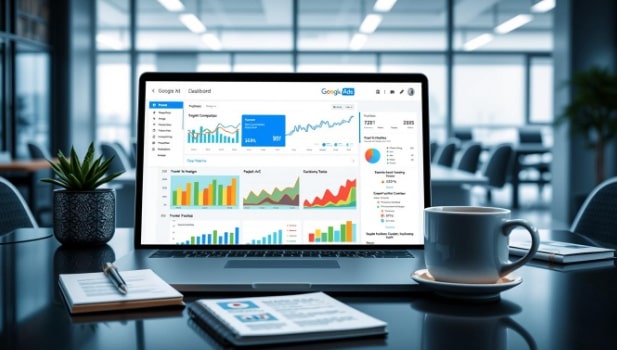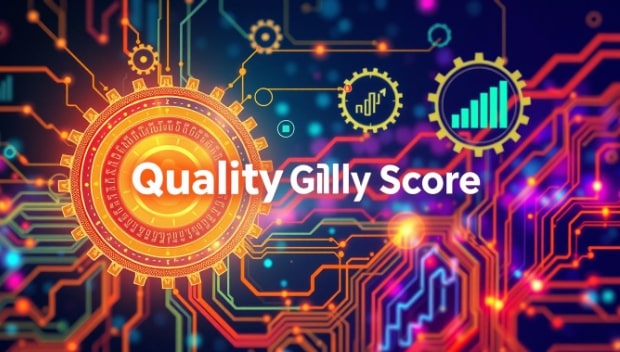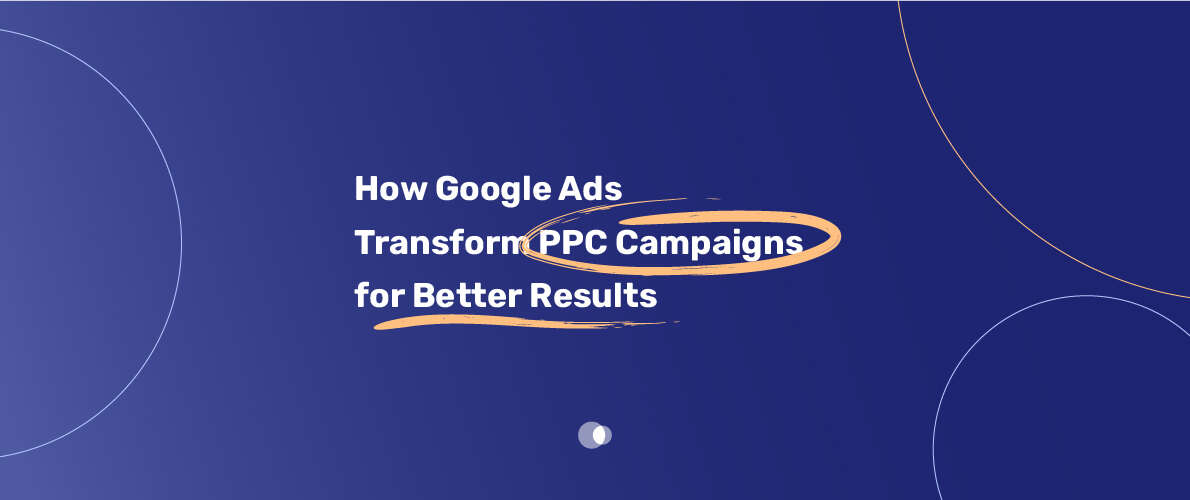The world of digital marketing has changed a lot with Google Ads (formerly AdWords). This powerful tool helps advertisers make their digital ads better. It lets them get amazing results for their businesses.
Table of Contents
By knowing how Google Ads works and using its advanced features, marketers can do great things. They can make their PPC campaigns work better than ever before.

A sleek digital workspace featuring a laptop displaying the Google Ads dashboard, surrounded by colorful charts and graphs illustrating PPC campaign performance, vibrant data analytics elements, a notepad with strategic notes, and a cup of coffee, all set against a modern office backdrop.
Key Takeaways
- Google Ads has evolved from AdWords, offering marketers more advanced features and capabilities.
- Leveraging machine learning and smart bidding strategies can significantly improve campaign performance.
- Audience segmentation and custom targeting options enable precise targeting, enhancing PPC campaign effectiveness.
- Optimizing Quality Score and effectively managing budgets are crucial for maximizing ROI.
- Integrating performance tracking and analytics helps marketers make data-driven decisions.
Understanding the Evolution of Google Ads Platform
The world of digital ads has changed a lot over time. At the center of this change is the Google Ads platform. Once called Google AdWords, it has grown into a full PPC solution. This helps businesses connect with their audience better.
From AdWords to Google Ads: Key Milestones
Google AdWords started in 2000 as a new way for ads to reach people. It used keywords to target ads. Over the years, it got many updates and a new name, Google Ads, in 2018. This change showed the platform’s growth and a new approach to digital marketing.
Core Components of Modern Google Ads
- Expanded Targeting Options: Google Ads now has many ways to target ads. You can target by demographics, location, and behavior. This helps advertisers find their perfect customers.
- Automated Bidding Strategies: The platform uses machine learning for bidding. This helps advertisers get the most from their ads.
- Expanded Ad Formats: Google Ads supports many ad types. You can use text, display, video, and shopping ads. This makes campaigns more engaging and attractive.
Platform Integration Capabilities
Google Ads is great because it works well with other Google tools and third-party apps. Advertisers can use data from Google Analytics and Google Merchant Center. This helps create better PPC campaigns.
The Google AdWords history shows the platform’s constant growth. It now has strong targeting, automated tools, and works well with other apps. Google Ads is key for businesses to get real results from their PPC efforts.
Google Ads Transform PPC Campaigns Through Advanced Targeting
In the fast-changing world of digital marketing, Google Ads stands out as a key tool for advertisers. It helps them fine-tune their PPC campaigns. With advanced audience segmentation and behavioral targeting, marketers can now pinpoint their ideal customers with great accuracy.
Google Ads is unique because of its wide range of targeting options. Advertisers can target users by demographics, interests, and behaviors. This ensures their ads reach the most interested audience.
- Demographic Targeting: Advertisers can target users by age, gender, and more. This lets them tailor their messages to specific groups.
- Interest-Based Targeting: Google Ads helps marketers reach users based on their online interests. This way, they can connect with people who might be interested in their products or services.
- Behavioral Targeting: This feature lets advertisers target users based on their past actions. This means they can deliver ads that are more relevant and personal.
Using these advanced PPC targeting strategies, advertisers can make their campaigns more effective. This leads to higher engagement, conversions, and a better return on investment.
| Targeting Approach | Description | Potential Benefits |
| Demographic Targeting | Targeting users based on age, gender, income, and other demographic factors | Increased relevance and engagement, improved conversion rates |
| Interest-Based Targeting | Reaching users based on their online interests and browsing habits | Better targeting of potential customers, higher click-through and conversion rates |
| Behavioral Targeting | Targeting users based on their past actions, such as website visits and purchase history | Personalized ad experiences, improved campaign performance, and higher ROI |
Google Ads uses audience segmentation and behavioral targeting to help advertisers create effective PPC campaigns. These campaigns are personalized and resonate with the target audience. This leads to measurable results and a stronger return on investment.
Leveraging Machine Learning in Google Ads
The digital advertising world has changed a lot thanks to machine learning. In Google Ads, this tech has changed how campaigns are run. It makes them more efficient and effective. Machine learning powers smart bidding and automated campaign tweaks, making Google Ads better.
Smart Bidding Strategies
Machine learning is changing PPC with smart bidding. These algorithms look at lots of data to adjust bids in real time. This ensures ads reach the right people, helping you meet your goals.
Automated Campaign Optimization
Manual campaign tweaks are a thing of the past. Automated PPC optimization uses machine learning to make things easier. It watches your campaigns, finds ways to improve, and makes changes on its own. This saves you time and effort.
Performance Max Capabilities
Google Ads has a new feature called Performance Max. It uses machine learning to reach your goals across different platforms. This means better ads for your audience, leading to better results for you.
As digital ads keep changing, machine learning in Google Ads will play a bigger role. Using these advanced tools, marketers can stay ahead, work smarter, and get more from their PPC efforts.
Maximizing ROI with Google Ads Attribution Models
In the fast-paced world of digital ads, knowing your PPC campaign’s ROI is key. Google Ads has many attribution models to help you see your marketing’s real impact. This way, you can make smart choices to boost your campaign’s success.
Google Ads shines with its conversion tracking tools. It tracks how customers interact with your ads at different points. This helps you see which marketing channels are working best, giving you a clear view of your campaign’s success.
The multi-channel attribution models in Google Ads offer more than just the last click. They show the whole customer journey. You can choose from simple last click to advanced data-driven attribution. This lets you match your attribution to your business goals and see the real effect of PPC attribution.
- Last Click: Attributes the conversion to the last ad clicked before the conversion.
- First Click: Attributes the conversion to the first ad clicked in the customer journey.
- Linear: Distributes the credit for the conversion equally among all touchpoints.
- Time Decay: Assigns more credit to touchpoints closer to the conversion.
- Data-Driven: Uses machine learning to dynamically allocate credit based on the unique contribution of each touchpoint.
Choosing the right attribution model helps you understand your campaign better. You can spot the top marketing channels and make smart choices to boost your PPC attribution strategy. This leads to higher ROI.

A visually dynamic representation of various PPC attribution models, featuring distinct sections illustrating first-click, last-click, linear, time decay, and position-based approaches. Incorporate abstract elements like arrows, graphs, and digital interfaces to symbolize data flow and performance metrics. Use a modern color palette with vibrant tones to convey a sense of technology and innovation, while ensuring the overall composition emphasizes the interconnectedness of these models in optimizing advertising strategies.
“Accurate attribution is the foundation for making informed decisions and driving sustainable growth in your PPC campaigns.”
Using Google Ads attribution models lets you see the real value of your marketing. You can spend your budget wisely and get better returns from your PPC efforts.
Advanced Audience Segmentation Strategies
In today’s digital world, targeting your audience well is key. Google Ads has changed how marketers segment their audience. It offers advanced strategies that boost your PPC campaigns’ performance.
Custom Intent Audiences
Google Ads uses machine learning to help you create custom intent audiences. It looks at search queries and browsing habits. This way, you can make ads that really speak to your customers’ needs and interests.
This approach can lead to more clicks, conversions, and a better return on your ad spend.
Remarketing Lists for Search Ads
Remarketing is a strong tactic to reconnect with users who’ve shown interest in your brand. Google Ads lets you make remarketing lists for search ads (RLSA). You target people who’ve visited your site or interacted with your content.
By showing personalized ads to these leads, you can move them closer to making a purchase. This can increase your conversion rates.
Similar Audience Targeting
Similar audience targeting helps you reach new customers who are like your current ones. Google Ads uses complex algorithms to find these new users. It looks at what makes your current audience tick.
This strategy can be a big win for growing your customer base and expanding your business.
Using these advanced strategies, you can make the most of your Google Ads campaigns. You’ll deliver ads that really speak to your audience and bring in real results.
Quality Score Optimization Techniques
Mastering Professional Google Ads Audit is more than just setting up campaigns. A key factor is improving your ad quality score. This score shows how relevant and useful your ads and landing pages are to users.
To boost your ad quality score and improve PPC campaigns, try these techniques:
- Improve Ad Relevance: Make sure your ad copy matches the search query and user intent. Use relevant keywords, highlight benefits, and include a clear call-to-action.
- Enhance Landing Page Experience: Create a smooth and informative landing page that matches your ad’s promise. Make sure it’s mobile-friendly, fast, and focused on the user to boost conversions.
- Optimize Expected Click-Through Rate: Look at your ad’s past performance to improve your expected click-through rate (CTR). Try different ad formats, extensions, and messages to grab your audience’s attention.
Using these techniques can improve your ad quality score. This leads to better ad performance, lower costs, and enhanced PPC optimization. Making your landing page relevant is key, as it affects user experience and ad value.
| Optimization Technique | Key Benefits |
| Improve Ad Relevance | Increased ad quality score, higher ad visibility, and better ad performance |
| Enhance Landing Page Experience | Improved user engagement, reduced bounce rates, and higher conversion rates |
| Optimize Expected Click-Through Rate | Better ad positioning, lower cost-per-click, and more efficient budget allocation |

An abstract representation of a digital landscape, symbolizing the concept of Quality Score in PPC campaigns, featuring interconnected gears and graphs representing performance metrics, bright colors highlighting optimization techniques, and a dynamic flow of data resembling a vibrant circuit board.
“Optimizing your Google Ads quality score is like leveling up your PPC game – it unlocks greater performance, lower costs, and a more satisfied audience.”
Budget Management and Bid Adjustments
Effective PPC budget optimization and bid management are key to getting the most out of google ads audit. Smart strategies help unlock your ad campaign’s full potential. This leads to better results.
Smart Budget Allocation
Smart budgeting is the base of a winning campaign. Look at past data to find your best ad groups, keywords, and campaigns. Put more money into these areas. Then, adjust your budget as needed based on how things are doing now.
Seasonal Bid Modifications
Seasons change how people shop and ads perform. Smart advertisers tweak their bid strategies to match these changes. They up bids when it’s busy shopping time and lower them when it’s slow.
Device-specific Bidding
More people use mobile devices now. It’s important to adjust your bid management for different devices. Give mobile devices higher bids to grab the attention of people on the move. Lower bids for desktops, where people might not buy right away.
Using these advanced budget management and bid adjustment tactics, advertisers can really make their Google Ads work. This leads to better PPC budget optimization and more efficient campaign spend.
Performance Tracking and Analytics Integration
In the fast-paced world of digital marketing, PPC analytics and campaign performance metrics are key. Google Ads offers tools and features for tracking, analyzing, and optimizing campaigns. This helps advertisers get the most out of their efforts.
The Analytics dashboard is at the core of Google Ads’ tracking abilities. It’s a central place for detailed views of important metrics like impressions, clicks, conversions, and ROI. Advertisers can use this tool to understand their PPC campaigns better. They can spot areas for improvement and make smart choices to boost results.
- Understand the Role of Google Analytics Integration: By linking Google Ads with Google Analytics, advertisers get access to more advanced reports. This lets them track user actions, attribute conversions, and measure campaign impact.
- Leverage Custom Reporting and Dashboards: Google Ads allows advertisers to create custom dashboards and reports. This customization helps them dive deeper into performance analysis and make better data-driven choices.
- Utilize Automated Performance Alerts: Google Ads has smart alert systems. These systems notify advertisers of big performance changes. This helps them quickly spot and fix any issues or seize new opportunities in their campaign performance metrics.
By using Google Ads’ advanced PPC analytics and reporting, advertisers can deeply understand their campaign performance. They can make informed decisions and continually improve their data-driven marketing strategies.
“The data-driven insights provided by Google Ads’ analytics tools have been instrumental in optimizing our PPC campaigns and maximizing our return on investment.” – Jane Doe, Digital Marketing Manager
Conclusion
professional google ads audit services has grown into a key digital advertising tool. It can change PPC campaigns and improve results. By knowing the platform well, using advanced targeting, and focusing on quality score and ROI, marketers can achieve great success.
The future of PPC looks bright, with Google Ads leading the way. Marketers who keep up with Google Ads best practices can use new trends. This includes audience segmentation and AI-powered optimization.
For a PPC campaign to succeed, you need to understand Google Ads well. You also need to keep improving your strategy. By using the tips from this article, marketers can make their PPC campaigns successful. This will bring them the benefits of a top-notch digital advertising tool.
FAQ
1)What are the key features of the modern Google Ads platform?
The modern Google Ads platform has many advanced features. These include smart bidding strategies and automated campaign optimization. It also has Performance Max capabilities and works with various marketing tools.
2)How can Google Ads help with audience targeting and segmentation?
Google Ads offers powerful tools for targeting and segmentation. It has custom intent audiences and remarketing lists for search ads. It also has similar audience targeting to help advertisers reach their desired customers.
3)What is the importance of Quality Score optimization in Google Ads?
Quality Score optimization is key in Google Ads. It affects ad performance and cost. Improving ad relevance and landing page experience can boost Quality Score. This, in turn, makes PPC campaigns more efficient.
4)How can machine learning and AI-driven features in Google Ads transform PPC campaigns?
Google Ads uses machine learning and AI for smart bidding and campaign optimization. These features can greatly improve campaign performance and ROI. They make PPC campaigns more efficient and effective.
5)What role do attribution models play in measuring the success of Google Ads campaigns?
Attribution models are vital for measuring PPC campaign success in Google Ads. They help understand how different models affect conversion tracking. This knowledge guides advertisers in optimizing their campaigns based on data.
6)How can advanced budget management and bid adjustment strategies improve campaign efficiency?
Advanced budget management and bid strategies can enhance campaign efficiency. Techniques like smart budget allocation and seasonal bid changes are effective. They lead to better campaign performance and higher ROAS.
7)What are the key performance metrics and analytics tools available in Google Ads?
Google Ads offers a wide range of analytics tools. These include metrics like click-through rate and conversion rate. Advertisers can use these tools to make informed decisions and optimize their campaigns.



